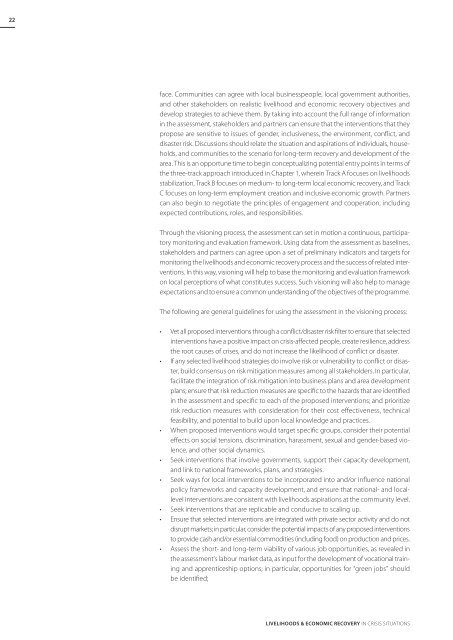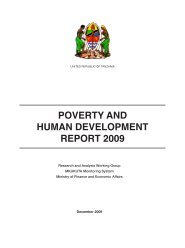Download PDF (4.08 MB) - ReliefWeb
Download PDF (4.08 MB) - ReliefWeb
Download PDF (4.08 MB) - ReliefWeb
Create successful ePaper yourself
Turn your PDF publications into a flip-book with our unique Google optimized e-Paper software.
22<br />
face. Communities can agree with local businesspeople, local government authorities,<br />
and other stakeholders on realistic livelihood and economic recovery objectives and<br />
develop strategies to achieve them. By taking into account the full range of information<br />
in the assessment, stakeholders and partners can ensure that the interventions that they<br />
propose are sensitive to issues of gender, inclusiveness, the environment, conflict, and<br />
disaster risk. Discussions should relate the situation and aspirations of individuals, households,<br />
and communities to the scenario for long-term recovery and development of the<br />
area. This is an opportune time to begin conceptualizing potential entry points in terms of<br />
the three-track approach introduced in Chapter 1, wherein Track A focuses on livelihoods<br />
stabilization, Track B focuses on medium- to long-term local economic recovery, and Track<br />
C focuses on long-term employment creation and inclusive economic growth. Partners<br />
can also begin to negotiate the principles of engagement and cooperation, including<br />
expected contributions, roles, and responsibilities.<br />
Through the visioning process, the assessment can set in motion a continuous, participatory<br />
monitoring and evaluation framework. Using data from the assessment as baselines,<br />
stakeholders and partners can agree upon a set of preliminary indicators and targets for<br />
monitoring the livelihoods and economic recovery process and the success of related interventions.<br />
In this way, visioning will help to base the monitoring and evaluation framework<br />
on local perceptions of what constitutes success. Such visioning will also help to manage<br />
expectations and to ensure a common understanding of the objectives of the programme.<br />
The following are general guidelines for using the assessment in the visioning process:<br />
• Vet all proposed interventions through a conflict/disaster risk filter to ensure that selected<br />
interventions have a positive impact on crisis-affected people, create resilience, address<br />
the root causes of crises, and do not increase the likelihood of conflict or disaster.<br />
• If any selected livelihood strategies do involve risk or vulnerability to conflict or disaster,<br />
build consensus on risk mitigation measures among all stakeholders. In particular,<br />
facilitate the integration of risk mitigation into business plans and area development<br />
plans; ensure that risk reduction measures are specific to the hazards that are identified<br />
in the assessment and specific to each of the proposed interventions; and prioritize<br />
risk reduction measures with consideration for their cost effectiveness, technical<br />
feasibility, and potential to build upon local knowledge and practices.<br />
• When proposed interventions would target specific groups, consider their potential<br />
effects on social tensions, discrimination, harassment, sexual and gender-based violence,<br />
and other social dynamics.<br />
• Seek interventions that involve governments, support their capacity development,<br />
and link to national frameworks, plans, and strategies.<br />
• Seek ways for local interventions to be incorporated into and/or influence national<br />
policy frameworks and capacity development, and ensure that national- and locallevel<br />
interventions are consistent with livelihoods aspirations at the community level.<br />
• Seek interventions that are replicable and conducive to scaling up.<br />
• Ensure that selected interventions are integrated with private sector activity and do not<br />
disrupt markets; in particular, consider the potential impacts of any proposed interventions<br />
to provide cash and/or essential commodities (including food) on production and prices.<br />
• Assess the short- and long-term viability of various job opportunities, as revealed in<br />
the assessment’s labour market data, as input for the development of vocational training<br />
and apprenticeship options; in particular, opportunities for “green jobs” should<br />
be identified;<br />
Livelihoods & Economic Recovery in Crisis Situations





